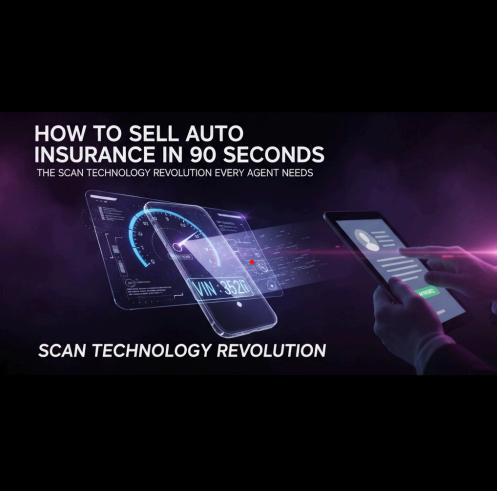The insurance industry stands at a technological inflection point where artificial intelligence and optical character recognition (OCR) are fundamentally reshaping how agents conduct business. Traditional auto insurance sales processes, which historically required 15-30 minutes of data entry and document review per quote, are being compressed into lightning-fast 90-second transactions through revolutionary scan technology implementations.
The Current State of Insurance Sales Inefficiency
Insurance agents across the United States continue to struggle with antiquated processes that consume valuable selling time. The typical auto insurance quote requires manual entry of vehicle identification numbers, registration details, coverage preferences, and personal information: a process that research indicates consumes up to 90% of an agent’s administrative workload. This inefficiency directly impacts revenue potential, with top-performing agents reporting that administrative tasks prevent them from engaging with an average of 12-15 additional prospects daily.
Market analysis reveals that agents utilizing traditional quoting methods average 8-12 quotes per day, while their technology-enhanced counterparts process 25-40 quotes in the same timeframe. This productivity gap represents a significant competitive disadvantage in an increasingly digital marketplace where consumer expectations for instant service continue to escalate.

The AI-Powered OCR Revolution
Advanced optical character recognition technology has emerged as the cornerstone of rapid insurance sales transformation. Modern AI OCR systems can scan vehicle registration documents and automatically extract critical data points including vehicle identification numbers, registration dates, vehicle classifications, and ownership details within seconds of document capture.
Industry testing demonstrates that AI OCR technology requires training with only 50 document examples to achieve reliable data extraction capabilities. These systems maintain accuracy rates exceeding 95% even under suboptimal scanning conditions, utilizing integrated plausibility checks to fill gaps in incomplete or partially obscured documents.
The technology operates through sophisticated machine learning algorithms that recognize document structures and data patterns across multiple state registration formats. This adaptability ensures consistent performance regardless of regional document variations or formatting differences between jurisdictions.
Deconstructing the 90-Second Sales Process
The revolutionary sales methodology unfolds through four distinct phases that compress traditional workflows into a streamlined digital interaction:
Phase One: Document Capture (10 seconds) Agents utilize mobile devices or desktop scanners to capture high-resolution images of customer vehicle registration documents. Advanced systems accommodate various lighting conditions and document orientations, ensuring reliable capture regardless of environmental factors.
Phase Two: Data Extraction (15 seconds) AI OCR engines process scanned documents, automatically identifying and extracting relevant data fields. The system recognizes vehicle identification numbers, registration classifications, ownership details, and validity periods while cross-referencing information against automotive databases for accuracy verification.

Phase Three: Quote Generation (45 seconds) Extracted vehicle data populates integrated rating engines that calculate premium options across multiple coverage scenarios. Advanced systems present agents with real-time pricing for various deductible combinations, coverage limits, and optional coverages, enabling immediate customer consultation.
Phase Four: Policy Presentation and Closing (20 seconds) Agents present customized quote options through mobile-optimized interfaces, facilitating immediate policy selection and electronic signature capture. Integrated payment processing capabilities enable instant policy binding and documentation delivery.
Quantifiable Impact on Agent Productivity
Statistical analysis of early adopters reveals transformative productivity improvements across key performance metrics. Agents implementing scan technology report average quote-to-close ratios improving from 12:1 to 6:1, indicating higher conversion rates through reduced customer friction and enhanced professional presentation.
Time allocation studies demonstrate that technology-enabled agents redirect previously administrative hours toward relationship building and prospecting activities. The average agent recovers 3.2 hours daily through automated document processing, representing a 40% increase in customer-facing time availability.
Revenue analysis indicates that scan technology adopters experience average premium growth of 23% within six months of implementation, driven by increased quote volume and improved closing ratios. Top-performing agents utilizing the technology report generating 45-60 quotes daily compared to industry averages of 15-20 quotes.

Customer Experience Enhancement
Consumer research demonstrates strong preference for streamlined insurance interactions, with 78% of respondents indicating frustration with traditional lengthy quoting processes. Scan technology addresses these concerns by reducing customer time investment from 20-30 minutes to under two minutes for complete quote generation and policy binding.
The technology eliminates common customer pain points including repetitive information requests, data entry errors, and extended waiting periods for quote preparation. Digital document processing ensures accuracy while creating seamless interaction flows that enhance customer satisfaction scores.
Market surveys indicate that customers experiencing 90-second quote processes demonstrate 65% higher likelihood to complete purchases compared to traditional sales interactions. This correlation suggests that speed directly influences buying decisions in competitive insurance markets.
Implementation Considerations for Modern Agencies
Successful scan technology deployment requires strategic consideration of existing agency infrastructure and workflow integration points. Agencies must evaluate current management systems for API compatibility and data synchronization capabilities to ensure seamless technology adoption.
Staff training represents a critical implementation component, with most agencies requiring 2-3 weeks for complete workflow integration. Training programs should emphasize proper document capture techniques, system navigation, and customer interaction protocols to maximize technology benefits.
Technology vendors typically provide comprehensive onboarding support including system configuration, staff training, and performance monitoring during initial deployment phases. Agencies should prioritize vendors offering robust customer support and regular system updates to maintain competitive advantages.

Regulatory and Compliance Implications
Scan technology implementations must align with state insurance regulations governing electronic document processing and digital signature requirements. Agencies should consult legal counsel to ensure compliance with jurisdiction-specific requirements for policy binding and documentation retention.
Data security considerations become paramount when implementing document scanning capabilities, requiring robust encryption protocols and secure data transmission standards. Agencies must implement comprehensive cybersecurity measures to protect customer information throughout the digital processing workflow.
Quality assurance protocols should include regular accuracy audits of OCR data extraction to maintain regulatory compliance and minimize errors that could impact policy validity or claims processing.
Future Industry Implications
The adoption of 90-second sales technology represents the beginning of broader industry digitization trends that will reshape insurance distribution models. Early adopters are positioning themselves advantageously for continued market evolution toward increasingly automated sales processes.
Emerging technologies including artificial intelligence-powered risk assessment and real-time underwriting capabilities will further compress sales cycles while enhancing accuracy and profitability. Agencies investing in current scan technology establish foundations for seamless integration of future innovations.
Market analysis suggests that scan technology adoption will become essential for competitive viability within 24 months, as consumer expectations align with technology-enabled service standards. Agencies delaying implementation risk significant market share erosion to technology-forward competitors.
The insurance industry’s transformation toward instant, digital-first sales processes creates unprecedented opportunities for agents willing to embrace technological advancement. Scan technology represents not merely an efficiency improvement but a fundamental reimagining of how insurance professionals serve customers in an increasingly connected marketplace.

